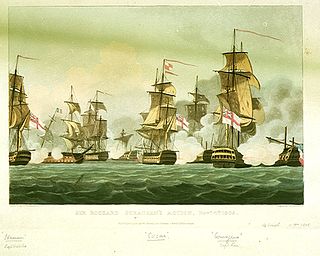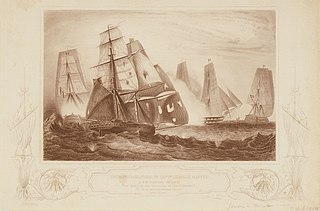
HMS La Hogue was a 74-gun third-rate ship of the line of the Royal Navy, launched on 3 October 1811 at Deptford. She was named after the 1692 Battle of La Hogue. "The La Hogue of 1811 [...] sported a green and chocolate lion, its grinning mouth displaying rows of white teeth and a huge red tongue."

HMS Royal Oak was a 74-gun third rate ship of the line of the Royal Navy, launched on 4 March 1809 at Dudman's yard at Deptford Wharf. Her first commanding officer was Captain Pulteney Malcolm.

HMS Majestic was a 74-gun third-rate ship of the line launched on 11 December 1785 at Deptford.

HMS Northumberland was a 74-gun third-rate ship of the line of the Royal Navy, built at the yards of Barnard, Deptford and launched on 2 February 1798. She carried Napoleon to his final exile on St Helena.
HMS Ramillies was a 74-gun third rate ship of the line of the Royal Navy, launched on 12 July 1785 at Rotherhithe. However, it was not actually commissioned by the Navy until February 1793. Its first Captain was Henry Harvey.

HMS Diadem was a 64-gun third rate ship of the line of the Royal Navy, launched on 19 December 1782 at Chatham. She participated in the Battle of Cape St Vincent in 1797 under Captain George Henry Towry.
HMS Dictator was a 64-gun third-rate ship of the line of the Royal Navy, launched on 6 January 1783 at Limehouse. She was converted into a troopship in 1798, and broken up in 1817.

HMS Plantagenet was a 74-gun third rate ship of the line of the Royal Navy, launched on 22 October 1801 at Woolwich. She was designed by Sir William Rule as one of the 'large class' 74s, and was the only ship built to her draught. As a large 74, she carried 24-pounder guns on her upper gun deck instead of the 18-pounder guns found on the middling and common class 74s.

HMS Courageux was a 74-gun third rate ship of the line of the Royal Navy, launched on 26 March 1800 at Deptford. She was designed by Sir John Henslow as one of the large class 74-gun ships, and was the only ship built to her draught. Unlike the middling and common class 74-gun ships, which carried 18-pounder long guns, as a large 74-gun ship, Courageux carried 24-pounders on her upper gun deck.

HMS Poictiers was a 74-gun Royal Navy third rate. This ship of the line was launched on 9 December 1809 at Upnor. During the War of 1812 she was part of the blockade of the United States. She was broken up in 1857.

HMS Illustrious, a 74-gun third rate ship of the line and the second of that name, was built by Randall & Brent at Rotherhithe where her keel was laid in February 1801. Launched on 3 September 1803, she was completed at Woolwich. She was first commissioned for the Channel Fleet under Captain Sir Charles Hamilton and was involved in the Battle of the Basque Roads in 1809, in which she won a battle honour, and in the expeditions against the docks at Antwerp and render the Schelde unnavigable to French ships. On 22 November 1810, Illustrious was amongst the fleet that captured Île de France on 3 December. She then took part in the Invasion of Java (1811) in Indonesia. She was refitted at Portsmouth (1813–17) and then laid up in reserve until recommissioned in 1832. She was laid up again in 1845, and later used as a guard ship, a hospital ship and, lastly, in 1854 she became a gunnery training ship and continued as one until she was broken up in 1868 in Portsmouth.
HMS Elizabeth was a 74-gun third-rate ship of the line of the Royal Navy, launched on 23 May 1807 at Blackwall.

HMS Venerable was a 74-gun third-rate ship of the line of the Royal Navy, launched on 12 April 1808 at Northfleet.

HMS Monmouth was a 64-gun third rate ship of the line of the Royal Navy, launched on 23 April 1796 at Rotherhithe. She had been designed and laid down for the East India Company, but the Navy purchased her after the start of the French Revolutionary War. She served at the Battle of Camperdown and during the Napoleonic Wars. Hulked in 1815, she was broken up in 1834.

HMS Bombay was a 74-gun third rate ship of the line of the Royal Navy, launched on 28 March 1808 at Deptford.

HMS Cressy was a 74-gun third rate ship of the line of the Royal Navy, launched on 7 March 1810 at Frindsbury.

HMS Clarence was a 74-gun third rate ship of the line of the Royal Navy, launched on 11 April 1812 at Turnchapel.

D'Hautpoul was a Téméraire class 74-gun French Navy ship of the line launched at Lorient on 2 September 1807. She was previously named Alcide and Courageux.

HMS Inconstant was a 36-gun Perseverance-class fifth-rate frigate of the Royal Navy. She had a successful career serving in the French Revolutionary and Napoleonic Wars, capturing three French warships during the French Revolutionary naval campaigns, Curieux, Unité, and the former British ship HMS Speedy.

HMS Ethalion was a Royal Navy 36-gun frigate, launched in 1802 at Woolwich Dockyard. She was eventually broken up in 1877.


















